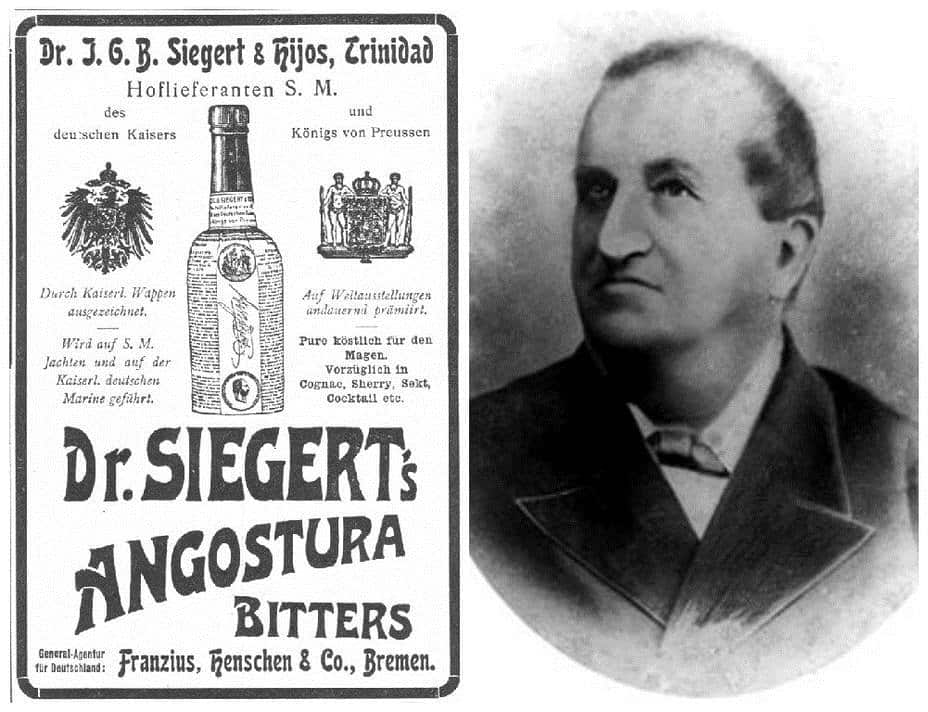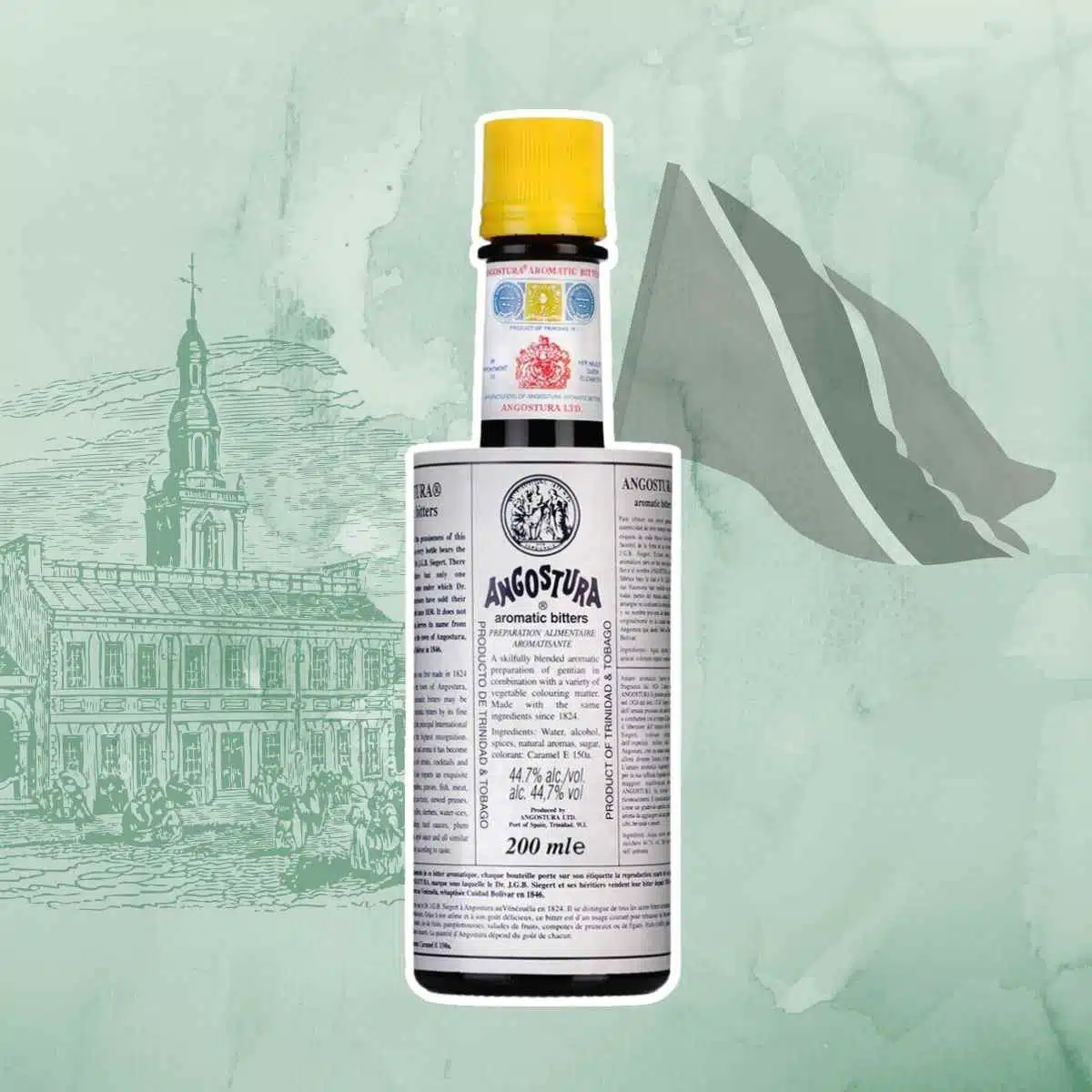When making an Old Fashioned cocktail, Angostura bitters are an indispensable flavoring ingredient for every bartender. Just one dash of bitters can change the taste of a drink and enhance the flavor profile. The small bottle with the bright yellow cap and the oversized white label is a product with an intriguing history. intense
Aromatic bitters have an intense, concentrated taste. Their predominant purpose is to deepen the flavor profile of cocktails. But where did they come from? Who invented the bitters? And why is the Angostura bitters label way too big for the bottle? Learn more about the origin of one of the most substantial cocktail ingredients.
Who invented Angostura Bitters?
The inventor of the famous Angostura Bitters is Dr. Johann Gottlieb Benjamin Siegert from Germany. He moved to the town of Angostura (today Ciudad Bolivar) in Venezuela, developing a formula for a medical tonic while working as surgeon general for Venezuelan military leader Simón Bolívar. Already by 1824, he had perfected the recipe for the "Amargo Aromatico" - Spanish for aromatic bitters.
Dr. Siegert created this mixture of water, alcohol, local herbs, and spices as a medical tonic for Bolívar's army. It was supposed to cure the upset stomachs of soldiers, and their original name was Dr. Siegerts Aromatic Bitters. Later it was named after the Venezuelan city of Angostura (now Ciudad Bolívar), where Siegert once lived.

How the bitters by Angostura became famous
In 1830, only six years after he finished the recipe for Angostura bitters, Siegert established a distillery in Venezuela to produce them. It took another 23 years until 1853 to export Angostura bitters and sell them abroad.
In England, this led to the famous Pink Gin, a pink cocktail created by a bartender adding a dash of Angostura bitters to Plymouth Gin. However, the combination of alcoholic beverages and bitters was not new. First came the Old Fashioned cocktail with Stoughton's bitters - a medical tonic invented in England in the early 1700s.
Still, Dr. Siegerts Aromatic Bitters were, and still are, different. Their secret recipe, including over 40 botanicals, created an unparalleled complex and bittersweet flavor profile.
The "Weltausstellung" in 1873, a world's fair held in Vienna, was the next step to international fame. There, it won the "Medal of Excellence," still depicted on the oversized label on the bottle of Angostura bitters.

In 1876, only three years later, they won another gold medal at the World Trade Fair held in Philadelphia. These two awards paved the way for the victory march of the famous aromatic bitters.
Of course, the invention of more classic cocktail recipes using these bitters in their recipe also contributed to the success. One of them is the Manhattan cocktail, invented in 1874.
Angostura aromatic bitters managed by Siegert's sons
After Dr. Siegert died in 1870, his sons Carlos, Alfredo, and Luis Siegert took over and relocated the business to Trinidad & Tobago. It was, by the way, also his sons who brought the bitters to the World Trade Fairs in 1873 and 1876, winning said medals.
Also, the famous bottle design with the too-big label came from their reign and stuck with the brand until today. Further, they brought the bitters to (back then) remote places like Australia, where it influenced Australia's national drink - a concoction of lemon, lime, and Ango bitters.
In 1903 Carlos Siegert died, leaving his two younger brothers, Luis and Alfredo, the owners of the secret formula and the company. Changes followed quickly, and in 1904 the company was renamed Amargo de Angostura. [1]
Also, Alfredo was announced as the royal purveyor of Angostura bitters for Prussia (1904), Spain (1907), and King George V of England (1910). In 1912, he even went public as a registered company in England. And after his brother Luis died in 1905, he was the sole person responsible for the business.
In 1921, the Angostura Bitters (Dr. J G B Siegert & Sons) Ltd was formed. Consequently, the company name changed to Angostura Limited. [2]
Why the Angostura label is so big
The look of the Angostura bitters bottle is quite unique: A bright yellow bottle cap and a large white label are the signature packaging. In fact, the oversized label is one of the most confusing things about aromatic bitters. Why is it so big?
It looks and feels like a marketing stunt. But it's most likely one of the best examples of miscommunication - despite the positive outcome.
When Dr. Siegert's sons joined the family business, they intended to enter a competition with their father's bitters. In preparation for said competition, they wanted to develop new packaging for the bitters. -A new bottle design in combination with a new label.

To save time, they split the tasks to get labels and bottles between them. But they forgot to discuss the exact measurements of said item. When they finally met again to bring both parts together, they realized their mistake: label and bottle sizes were not matching; -At all.
There was no time to do anything about it, so they entered the competition regardless - and lost! Still, for reasons unknown, they decided to stick with the packaging.
In the end, that decision paid off, as it made people remember the bottle as well as the brand, eventually accelerating their success. However, there are rumors that Alfredo wasn't so lucky with all his business decisions.
Was Angostura handed over to creditors?
It's said that some of Alfredo's speculations and business decisions failed and that he lost enormous amounts of money. It's even indicated that Angostura bitters were handed over to its creditors due to this development.
However, it's hard to find quality sources for the true history. The only sources I could find confirming this story don't mention details like dates or names of creditors.
The best of these sources is probably the book "Bitters: A Spirited History of a Classic Cure-All by Brad Thomas Parsons. The said passage from the book reads:

Modern days history
The classic version of aromatic bitters is still the most important product made by Angostura Limited. But today, the Angostura distillery in Port of Spain, Trinidad also produces Rum, including some premium bottles, soft drinks, and other bitters.
In 2007, they launched Angostura Orange bitters. As the name indicates, they combine complex orange flavors with their signature spices. Another thirteen years later, in 2020, Angostura released their third type of bitters - the Angostura Cocoa bitters.
In 2009, there was some media hype due to a shortage of renowned bitters. Many newspapers and bloggers suspected a production halt in Trinidad or product recalls. Later it turned out that Angostura indeed had to stop production as they had run into a shortage of ingredients.

